Analysis by Dr. Joseph Mercola
February 24, 2024
STORY AT-A-GLANCE
The Front Line COVID-19 Critical Care Alliance has updated its treatment protocols for
long COVID and post-jab injuries, adding time-restricted eating (TRE) and
photobiomodulation (PBM), using either the sun or near-infrared sauna
The primary benefit of TRE for these conditions is its ability to optimize your
mitochondrial function, which is key for recovery from any illness or disease. As a
general rule, I recommend compressing your eating window to between six and eight
hours, and fasting for the remaining 16 to 18 hours each day
Near-infrared light triggers production of melatonin in your mitochondria. Melatonin is
one of the most important antioxidant molecules in your body. Aside from having direct
antioxidant effects, it also stimulates the synthesis of glutathione and other important
antioxidants
Fifty-three percent of sunlight is near-infrared. Sauna Space also makes near-infrared
sauna bulbs that mimic the sun, providing 39% near-infrared light, but no UV
You can further optimize your mitochondria by combining PBM with methylene blue. This
combination has been shown to provide neuroprotective benefits. It can also address the
chronic fatigue that is so common in long COVID and post-jab injuries
The video above features the Front Line COVID-19 Critical Care Alliance’s (FLCCC)
weekly update for October 26, 2022, in which I reviewed the benefits of two of the latest
additions to the FLCCC’s long COVID recovery protocol,1 and their post-jab recovery
protocol:2 time-restricted eating (TRE) and photobiomodulation using either the sun or a near-infrared sauna. Leading the discussion are FLCCC cofounders Dr. Paul Marik and
Dr. Pierre Kory.
Time-Restricted Eating (TRE)
The vast majority of people eat across 12 hours or more, which is a recipe for metabolic
disaster. Health statistics bear this out. In July 2022, the Journal of the American
College of Cardiology3 posted an update on the metabolic fitness or flexibility of the
American population.
Metabolic fitness includes things like blood glucose and blood sugar, blood pressure
and weight, and metabolic flexibility refers to your body’s ability to seamlessly transition
between burning fat and carbohydrates as your primary fuel.
In 2016, 12.2% of Americans were considered metabolically fit.4 Two years later, in 2018,
only 6.8% of U.S. adults had optimal cardiometabolic health.5 That was four years ago,
so today, that ratio is probably even lower.
I believe at least 95% of Americans are by now metabolically unhealthy, which means
some 19 out of 20 people would benefit from TRE, as it’s one of the easiest yet most
powerful interventions for reducing insulin resistance, restoring metabolic flexibility and
losing excess body fat.
As it pertains to long COVID and post-jab recovery, the primary benefit of TRE is its
ability to optimize your mitochondrial function, which is key for recovery from any illness
or disease.
As a general rule, I recommend compressing your eating window to between six and
eight hours, and fasting for the remaining 16 to 18 hours each day. The timing of that
eating window is important though.
You want to avoid eating first thing in the morning (wait at least two or three hours) and
you want to avoid eating right before bed. Ideally, have your last meal at least three hours or more before bedtime. So, to give you an example, you could eat all your meals
between 10 a.m. and 6 p.m., or 11 a.m. and 5 p.m.
Near-Infrared Exposure and Melatonin
Another important mitochondrial tool is strategic use of near infrared light and its
impact on melatonin, which is one of the most important antioxidant molecules in your
body. Aside from having direct antioxidant effects, it also stimulates the synthesis of
glutathione and other important antioxidants like superoxide dismutase and catalase.
While commonly thought of as something produced only in the pineal gland of your
brain, which is produced in response to darkness, it only accounts for 5% of the
melatonin in your body. A couple of years ago, Dr. Russel Reiter published a
groundbreaking paper explaining that the vast majority, 95%, is actually made within the
mitochondria inside your cells,6 where it is produced in response to near-infrared light,
which could be from the sun or near-infrared sauna bulbs.
Considering melatonin combats oxidative damage, it makes sense that most of it is
made in your mitochondria, because that’s precisely where a majority of the oxidative
damage occurs — in the mitochondrial electron transport chain. So, it’s a truly
phenomenal system. The key that makes this system work, however, is exposure to
near-infrared light. To dive deeper into this topic, see my interview with Reiter.
This is one of the reasons why exposing as much bare skin as possible to the sun for an
hour a day is my No. 1 recommendation to optimize your health. And it’s free. As you can
see in the graph below, 52% of the sun’s rays are near-infrared.
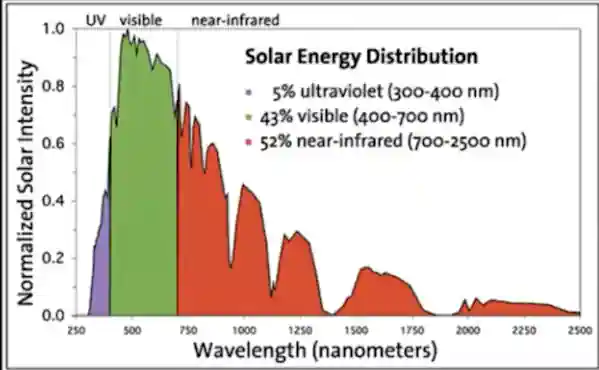
Concerning Skin Cancer
As noted by Marik, many shy away from sun exposure as a source of UV and near IR for
fear of skin cancer. This is yet another example of medical propaganda. The fact is the
sun is a nutrient that will actually decrease your risk of both skin cancer and internal
cancers, provided you avoid sun burn.
Another little-known fact is that the fats in your diet can, to a significant degree, dictate
how predisposed you are to burning and sun-related skin damage. The key is to limit
omega-6 fats in your diet. That means avoiding processed foods, foods cooked in seed
oils, and animal foods raised on seed oils and/or grains, such as chicken and pork.
Omega-6 seed oils are primarily linoleic acid (LA), a polyunsaturated fat that is highly
susceptible to oxidative damage when exposed to a variety of stressors. What’s more LA
can remain embedded in your cell membranes and tissues for up to seven years, all the
while wreaking havoc and causing damage through oxidative stress.
As it pertains to sun exposure, the LA embedded in your cell membranes gets activated
by the exposure to the sun, which contributes to skin damage. Once you drastically
reduce or eliminate LA from your diet, your risk of sunburn will be dramatically reduced
over time, as will your risk of skin cancer.
General Benefits of Photobiomodulation (PBM)
Light in the red and infrared range has several important health benefits, including:
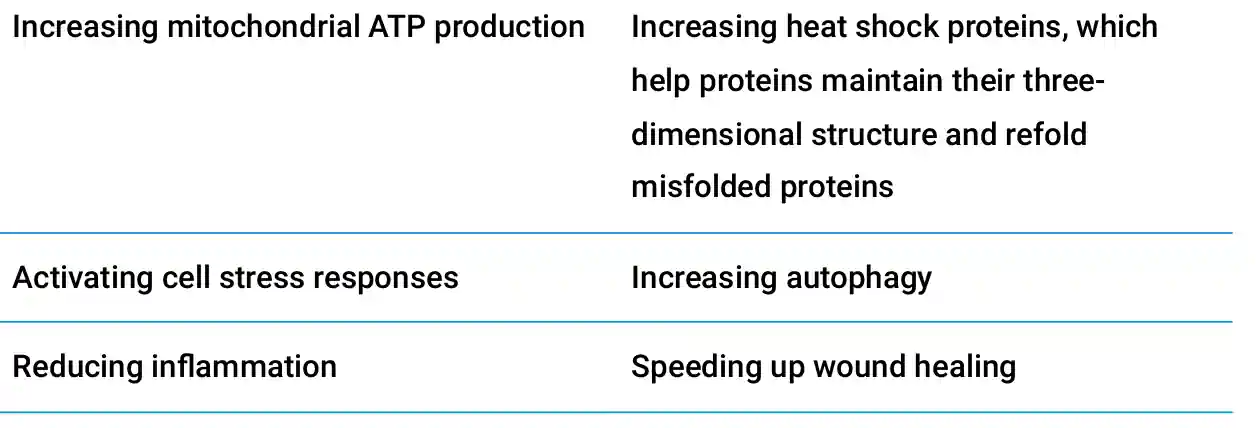 Near-infrared light specifically, which is invisible to the naked eye, can penetrate 5 to 7
Near-infrared light specifically, which is invisible to the naked eye, can penetrate 5 to 7
inches into your body, into your subcutaneous tissue, muscle tissue, bone and even
interior tissues as you can see by the graphic below. This is in stark contrast to far IR
that most saunas use, which penetrates less than half an inch.
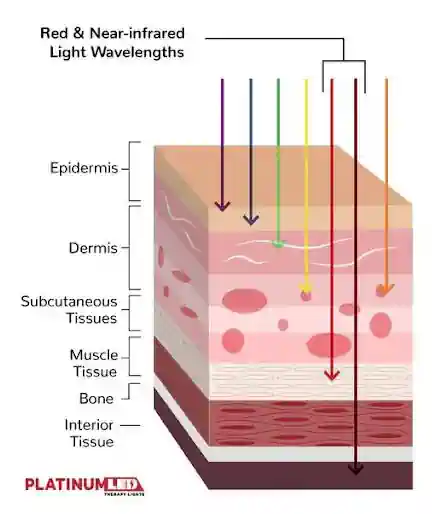
This is what makes near-infrared saunas so useful, as you can boost melatonin
production throughout your entire body, including your organs, thereby detoxing and
healing them. In comparison, far-infrared penetrates only 1 to 2 millimeters, yet far-
infrared is, unfortunately, what most commercially available electrical saunas use.
General Benefits of Sauna Therapy
Research has demonstrated sauna use can:
- Improve cardiovascular fitness and lower your risk of death from cardiovascular disease, stroke and heart attack
- Lower your blood pressure
- Lower your risk of dementia
- Improve your mood and mental health, and reduce symptoms of depression, in part by
sensitizing opioid receptors - Strengthen your immune function
- Reduce all-cause mortality
- Improve athletic endurance
- Reduce inflammation by lowering c-reactive protein, and increasing IL-10 and IL-6 (aka, myokine), and activating Nrf2
- Activate and replenish stem cells
- Improve fasting glucose and insulin sensitivity
- Reduce the stress hormone cortisol7
All of these benefits occur in a dose-dependent manner, so the more frequent your
sauna use, the more robust your benefits will be. For example, using the sauna two to
three times a week has been shown to reduce your risk of cardiac death by about 22%
compared to once-a-week use, whereas those who use it seven times a week lower their
risk by 63%.
Similarly, those who use it four to seven times a week have a 40% lower all-cause
mortality risk than those who use it only once a week. To learn more about these and
other health benefits of sauna therapy, see “The Stunning Health Benefits of Sauna
Therapy.”
Different Saunas Provide Different Sets of Benefits
Many of the benefits listed above are related to the heat exposure alone, and for heat, it
doesn’t much matter what type of sauna you use: a traditional thermal Finnish sauna, a
far-infrared sauna or a near-infrared one. Although one needs to be careful as many far
IR saunas simply do not get hot enough to generate heat shock proteins and detox.
Near-infrared saunas have benefits that you simply cannot get with the others. Below is
a simple chart showing the differences in benefits between the three primary types of
saunas available in the U.S.
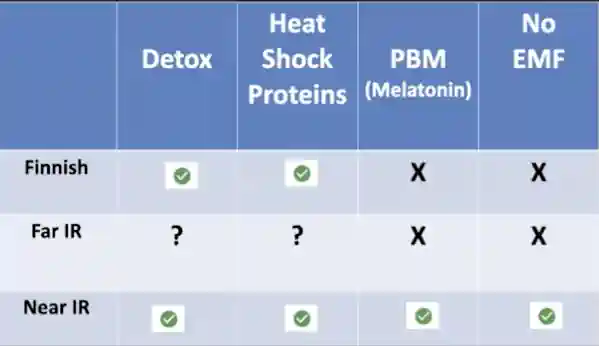
As you can see, all will provide detoxification to some degree (although the detox
provided by far-infrared is questionable, seeing how it barely penetrates your tissue. Far-
infrared saunas also oftentimes cannot get hot enough for efficient detox, which
requires you to sweat profusely). Detoxification is something just about every person
needs, as we’re surrounded by toxins and take them in with both food and water.
Unstructured proteins tend to aggregate, and these aggregates can then form plaques in your vascular
system or brain, contributing to neurodegenerative diseases and cardiovascular problems. Heat shock proteins serve a really crucial role in keeping these kinds of problems at bay.
All three will also generate heat shock proteins to some degree. As mentioned earlier,
heat shock proteins are important because they refold misfolded proteins and all of us
have misfolded proteins.
Unstructured proteins tend to aggregate, and these aggregates can then form plaques in
your vascular system or brain, contributing to neurodegenerative diseases and
cardiovascular problems, so heat shock proteins serve a really crucial role in keeping
these kinds of problems at bay.
Again, there’s a question mark by far-infrared, as many far-infrared saunas can’t get hot
enough. Near-infrared saunas also are nowhere near as hot as the Finnish-style sauna,
but they don’t need to be, due to the extreme penetration. You’ll sweat profusely and
activate heat shock proteins even though the air temperature is lower than a Finnish
thermal sauna.
You can determine if your sauna is hot enough for you by measuring your temperature
with an oral thermometer. It should be around 101 to 103 degrees Fahrenheit as you
finish your sauna. You could also weigh yourself before and after the sauna and you
should lose between 2 and 4 pounds of water (sweat). This would be one pint to one
quart of water.
Next on the list, melatonin production. This can only be achieved in a near-infrared
sauna, as melatonin is not produced in response to mere heat or light in the far-infrared
range.
The Importance of an EMF-Free Sauna
Lastly, there’s the issue of adverse health effects of electromagnetic fields (EMF). I
published a book about this in early 2020, called “EMF*D.” Virtually no far-infrared
saunas on the market are truly EMF-free, even when advertised as such. The reason for this is because EMFs include both electric and magnetic fields, and most saunas
address only one of these.
If you’re using a wood-burning Finnish sauna, it will of course be EMF-free, but almost
no one has that in the U.S. Most Finnish-style saunas sold here use electrical heaters
and emit electrical fields. When you’re detoxing, you want to be in a parasympathetic
environment. When you’re exposed to EMFs, it activates your sympathetic nervous
system, which impairs your ability to detox properly.
The near-infrared Sauna Space sauna that I use and recommend has no EMFs. And,
again, while traditional and some FIR saunas can provide outstanding benefits in detox
and heat shock protein generation, neither of them provide the light wavelengths to
generate PBM benefits.
What Make Sauna Space’s Bulbs so Unique
Sauna Space uses incandescent heat lamps (shown in the photo further below) that
produce the majority of the heat as mid-infrared, plus a significant percentage of near-
and mid-infrared frequencies that provide PBM benefits. The spectral distribution of
these bulbs is shown in the following graph.
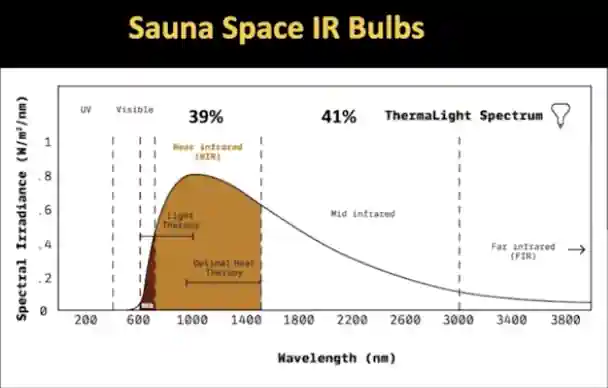
As mentioned, 53% of sunlight is near-infrared, and the Sauna Space bulbs mimic
sunlight with 39% of the light being in the near-infrared range. (They do not have any UV
light, however, so you will not make vitamin D. The bulbs only mimic sunlight in terms of
their infrared distribution.) This is vastly superior to the average red heat lamp (graph
below), in which only 14% is near-infrared.
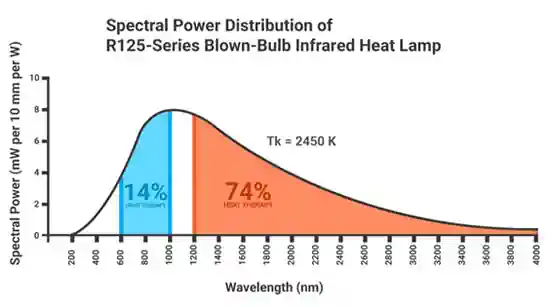
In “Near-Infrared Sauna Therapy — A Key Biohack for Health,” I provide instructions for
how you can create your own near-infrared sauna using the Sauna Space near-infrared
bulbs.
Sauna Space is the only company that I know of that makes these kinds of bulbs, so
they’ve really cornered the market, at least for now. Using these, you’ll be able to make
the absolute best, most effective sauna there is, as you’re getting both the standard
sauna benefits and the PBM benefits, and none of the EMF hazards.

If you want to further optimize your mitochondria, you can combine PBM (the near-
infrared light) with methylene blue. A 2020 paper8 in Translational Neurodegeneration
reviews the benefits of this combination, specifically as it refers to neuroprotection. I
believe this combination can also be very valuable in the treatment of long COVID and in
post-jab recovery, many symptoms of which are neurological in character.
In 1890, the German physician Dr. Paul Ehrlich published a study showing methylene
blue could effectively treat malaria. Interestingly, many of the most useful drugs for
COVID are antimalarial and antiparasitic drugs such as hydroxychloroquine. Well,
methylene blue is the parent molecule to chloroquine.
Methylene blue can be particularly useful for addressing the fatigue that is so common
in long COVID. You can learn more in “The Surprising Health Benefits of Methylene Blue,”
in which I interview Francisco Gonzalez-Lima, Ph.D., who has spent many years studying
this drug.
In closing, you can find the latest, updated protocols for long COVID9 and post-jab
injuries10 on the FLCCC’s website. These protocols are continually updated as the team
learns more.
Sources and References
1, 9 FLCCC Alliance, I-RECOVER Long COVID Treatment
2, 10 FLCCC Alliance, I-RECOVER Post-Vaccine Treatment Protocol
3 Journal of the American College of Cardiology July 2022; 80(2): 138-151
4, 5 Metab Syndr Relat Disord February 2019; 17(1): 46-52
6 Physiology February 5, 2020
7 YouTube The Science & Health Benefits of Deliberate Heat Exposure | Huberman Lab Podcast #69
8 Translational Neurodegeneration 2020; 9: 19
